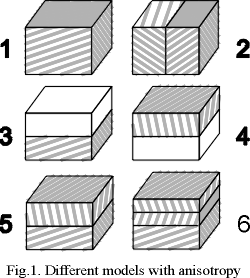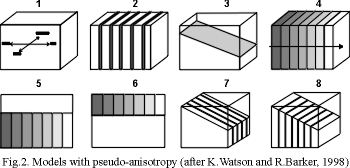 AnisPack software,
developed in our laboratory, includes several programs, which allow us
to fulfill modeling next anisotropy situations, shown on fig.1: 1. Halfspace;
2. Vertical contact; 3. Anisotropic halfspace covered with isotropic overburden;
4. Two-layered model with upper anisotropic layer; 5. Two-layered model
with arbitrary anisotropy in each layer. The sixth multi-layered model
is not realized yet in software. According to K.Watson and R.Barker, 1998
the most cases in azimuthal resistivity survey (ARS) are not really anisotropic,
but give us examples of pseudo-anisotropy. The important problem of ARS
consists in distinction of these cases: 1.- a homogeneous isotropic earth;
2.- a homogeneous anisotropic
AnisPack software,
developed in our laboratory, includes several programs, which allow us
to fulfill modeling next anisotropy situations, shown on fig.1: 1. Halfspace;
2. Vertical contact; 3. Anisotropic halfspace covered with isotropic overburden;
4. Two-layered model with upper anisotropic layer; 5. Two-layered model
with arbitrary anisotropy in each layer. The sixth multi-layered model
is not realized yet in software. According to K.Watson and R.Barker, 1998
the most cases in azimuthal resistivity survey (ARS) are not really anisotropic,
but give us examples of pseudo-anisotropy. The important problem of ARS
consists in distinction of these cases: 1.- a homogeneous isotropic earth;
2.- a homogeneous anisotropic  earth;
3.- a dipping interface separating two homogeneous isotropic layers; 4.-
a laterally changing resistivity model; 5.- that with isotropic overburden;
6.- two-layered model with a laterally changing resistivity in upper layer;
7.- a dipping interface with anisotropy in lower layer with its orientation
in dip direction; 8.- that with anisotropy orientation in strike direction.
We classify all cases as anisotropy, inhomogeneity and inhomogeneity with
anisotropy. Anisotropy gives rather weak influence on resistivity data
in comparison with inhomogeneity. That is why we recommend to apply more
sensitive to anisotropy non-linear arrays instead of collinear arrays.
earth;
3.- a dipping interface separating two homogeneous isotropic layers; 4.-
a laterally changing resistivity model; 5.- that with isotropic overburden;
6.- two-layered model with a laterally changing resistivity in upper layer;
7.- a dipping interface with anisotropy in lower layer with its orientation
in dip direction; 8.- that with anisotropy orientation in strike direction.
We classify all cases as anisotropy, inhomogeneity and inhomogeneity with
anisotropy. Anisotropy gives rather weak influence on resistivity data
in comparison with inhomogeneity. That is why we recommend to apply more
sensitive to anisotropy non-linear arrays instead of collinear arrays.
V.A. Shevnin, I.N. Modin
Tel. & fax: (7-095) 939 49 63
E-mail: sh@geophys.geol.msu.ru